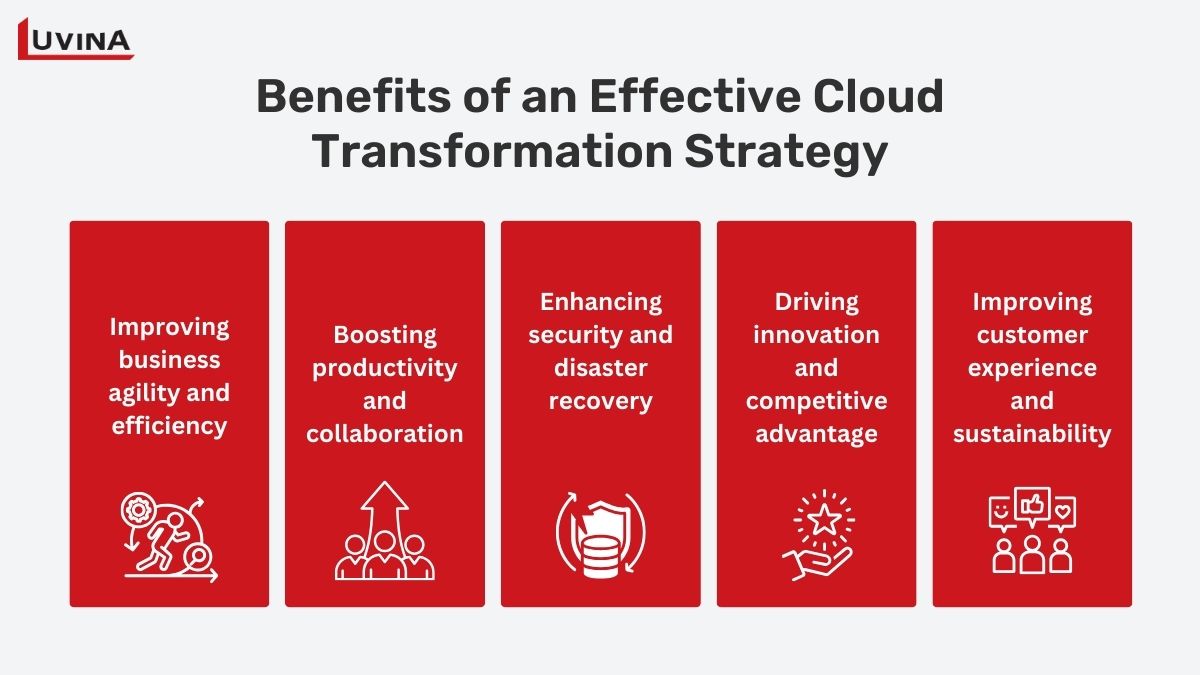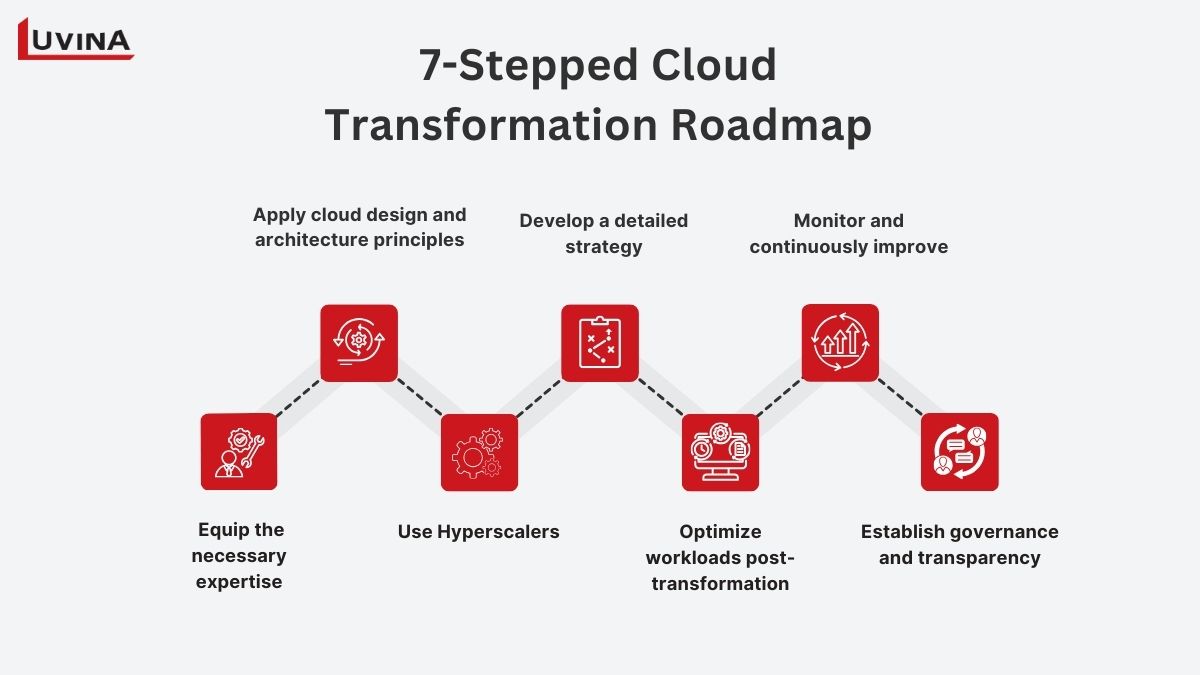Cloud transformation is a complex and challenging process that requires a clear cloud transformation strategy. However, it also brings significant benefits to businesses. Knowledge of these benefits is the reason more than 90% of companies are now using the cloud service market, expected to grow up to $2.5 trillion by the year 2030.
However, you cannot simply switch from traditional infrastructure to the cloud without careful planning. You require a cloud transformation strategy and a roadmap detail to enable your business to adapt to market changes and scale easily whenever growth increases.
In the following article, we will answer all your questions about cloud transformation strategies and provide a detailed guide on how to build and implement an effective cloud transformation roadmap.
What Is Cloud Transformation?
Cloud transformation is the process of moving an organization’s IT infrastructure, applications, and services to contemporary cloud computing and optimizing them for it. This most commonly includes the shift from traditional on-premises hardware or software to cloud-based solutions or a transition between different cloud environments.

Cloud transformation is changing the view that a company has toward the management and deployment of technology resources. The process enhances flexibility, scalability, and accessibility to infrastructure, helping to increase operational efficiency, drive innovation, and raise profits.
To ensure cloud transformation happens seamlessly within a company, there should be a good cloud transformation strategy. This mostly includes setting desired aims, checking on organizational readiness for cloud adoption, and flexible approach selection.
Why Businesses Require a Cloud Transformation Strategy?
A cloud transformation strategy guides businesses to leverage the maximum potential of the cloud, leaving a very positive impact on business operations. A well-designed cloud transformation roadmap helps in building a correct cloud infrastructure that aligns with business goals so that cloud adoption supports the organization’s vision, and missions, and enhances overall value.

Additionally, a detailed cloud transformation strategy makes it easier to evaluate and select cloud providers, reducing risk. With a clear plan and defined goals, businesses can more effectively communicate with providers to receive appropriate service recommendations. Stakeholders also have a foundation for tracking and collaborating throughout the transformation process.
Ultimately, clear planning from the outset will make the cloud transformation process smoother and more efficient. This plan should include stakeholder coordination, process standardization, change management, and resource optimization.
Benefits of an Effective Cloud Transformation Strategy
A well-crafted cloud transformation strategy, as commonly referred to, brings significant benefits and adaptability to a business. Here are some key advantages of having a cloud transformation strategy:

1. Improving business agility and efficiency
An effective strategy of cloud transformation boosts business efficiency and flexibility to great heights. Moving to the cloud will enable a company to quickly scale up its resources so that it aligns well with changing conditions and market demands. Efficiency gives way to faster launching of products and services, thus optimizing the overall operations of businesses.
Furthermore, a move to the cloud reduces the heavy investment load on hardware and infrastructure. It is based on a model where businesses pay only for the resources put in use, thereby reducing cost and making IT spending effective. Centralization of IT resources also ensures simple management and easier maintenance.
2. Boosting productivity and collaboration
A well-planned cloud transformation roadmap also increases productivity by providing seamless access to resources from anywhere. Employees can collaborate effectively, regardless of geographical barriers, improving overall efficiency. This is particularly beneficial for companies with remote work and collaborative projects. Moreover, cloud development platforms offer powerful data analytics tools that help businesses make better-informed decisions, enabling strategic planning and operational improvements.
3. Enhancing security and disaster recovery
Cloud technology can more effectively protect data and handle disaster recovery than a company would be able to if they managed it all themselves. The security aspects of cloud providers will give much value to businesses in terms of cybersecurity, thereby protecting data from various possible threats. Such security is also enhanced through and through by vigorous disaster recovery measures which help a company minimize this alternative downtime.
4. Driving innovation and competitive advantage
One of the other big advantages of a cloud migration strategy is access to leading technologies. Being at the forefront of upgrades, cloud providers offer service delivery that incorporates the latest innovations in machine learning, artificial intelligence, and big data analytics. The interaction with cloud providers opens up access to resellers who, in turn, equip businesses with these new technologies to take up insights and gain a competitive edge in the market.
5. Improving customer experience and sustainability
A cloud transformation roadmap can also enhance customer experience and promote environmental sustainability. Cloud-based applications allow businesses to deliver more personalized interactions and provide seamless multichannel services, leading to higher customer satisfaction. Additionally, moving to the cloud reduces reliance on energy-intensive on-premises data centers, minimizing carbon emissions and supporting environmental protection.
A Detailed Roadmap for Cloud Transformation: Step-by-Step
Creating a cloud transformation roadmap needs to be done step by step with careful planning. Here are 7 steps to help you develop and apply an effective cloud transformation strategy.

Step 1: Equip your team with the necessary expertise
The first step in creating a cloud transformation strategy is to assess what your team currently knows and can do with regard to the cloud. Identify any skill gaps and implement training to fill those gaps. Also, your team will need to learn continuously to stay current with changing technologies.
Step 2: Apply cloud design and architecture principles
When designing and implementing infrastructure for the cloud, choose a cloud-native architecture. This approach will help you leverage the scalability and flexibility inherent to the cloud. Additionally, consider integrating security throughout the design process, adhering to relevant regulations, and focusing on cost efficiency.
Step 3: Use Hyperscalers for Cloud Transformation
Consider using hyperscaler tools like GCP, AWS, and Azure based on factors such as scalability, functionality, pricing, and security features. You may work with qualified cloud partners to guide you in selecting, deploying, and customizing these tools to meet your specific needs.
Step 4: Develop a detailed transformation strategy
This is an important step in the process of cloud migration. A detailed migration plan specifies the sequence of migration, tools, and resources to be used for each particular activity.
Step 5: Optimize workloads post-transformation
An essential part of cloud management strategy is monitoring and analyzing resource usage after migration. Adjust your resources to match actual usage patterns, optimizing performance and minimizing costs.
Step 6: Monitor and continuously improve
Monitoring and constant improvement are important steps not just for the development of the cloud strategy but also for its ongoing management. Systematize monitoring tools; put in place key performance indicators and review them regularly to keep track. Also, consistently experiment with new technologies to optimize your cloud environment.
Step 7: Establish governance and transparency
Ensure your cloud transformation aligns with industry standards. You’ll also need to define clear governance policies, implement cost management tools, and establish auditing and compliance processes.
Strategy Implementation
To understand how an effective cloud transformation strategy can benefit your business, you can look at the following two case studies. These examples showcase how Luvina has helped companies from different industries perform various tasks to harness the power of the cloud.
1. Optimization of a Tourism Website System
Luvina successfully collaborated with a leading travel company in Japan to develop and maintain their tourism website. The client, not being an IT company, required Luvina to translate non-technical, user-focused desires into precise technical requirements. Luvina’s team demonstrated proficiency in multiple programming languages, including Java, Python, and SQL Oracle, to integrate diverse system components and meet the client’s needs.

By selecting experienced personnel, Luvina delivered a high-quality product on schedule, exceeding the client’s expectations and ensuring effective communication and independent problem-solving throughout the project.
2. Developing and Maintaining Credit Card Transaction Systems
Luvina Software partnered with a leading IT conglomerate in Japan to develop and maintain user authentication systems for credit card transactions on Nonstop servers, which are specialized for continuous operation in financial transactions. The client, a dominant player in Japan’s payment system sector, required strict adherence to processes and documentation, focusing on enhancing performance and scalability while ensuring system stability.

To meet these challenges, Luvina’s team committed to continuous learning, particularly in the complex field of credit card operations. We regularly compiled and shared knowledge, engaged in weekly learning sessions, and documented solutions to issues encountered during project deployment. This approach ensured that the team maintained high-quality work and met client expectations.
The project achieved significant milestones, including completing 50-60% of development tasks within the first month, maintaining product quality with minimal bugs, and demonstrating strong project management capabilities. The client’s satisfaction was evident in their praise for the team’s quick adaptation to new business requirements and techniques.
How can Luvina help?
Through the 2 case studies above, you’ve likely gained some insight into how Luvina can assist you in crafting a cloud transformation strategy and ensuring a smooth cloud transformation. In today’s business landscape, companies need the best technologies to succeed. Luvina understands this and is ready to collaborate with your business to deliver optimal business outcomes.
We have extensive experience working with and assisting companies across various sectors in their cloud transformation, including retail and e-commerce, human resources, manufacturing, real estate, healthcare, and more. As an ISO 9001 certified leader, Luvina is committed to delivering top-tier cloud services. Our team of over 750 stable software professionals is meticulous and well-versed in adapting to the latest technologies.
Importantly, throughout our collaboration and in helping businesses develop and execute their cloud transformation roadmaps, Luvina consistently upholds international security standards such as ISO 27001, ensuring that your data and intellectual property are kept secure.
Experience the power of Luvina’s cloud transformation services and unlock your business’s full potential with our innovative solutions today.
Related Posts:










Read More From Us?
Sign up for our newsletter
Read More From Us?
Sign up for our newsletter